James Maliszewski's Blog, page 40
October 11, 2024
The Darkest Shadows
Whatever one's feelings about the setting itself, Gerald Brom's artwork for Dark Sun was truly stunning. Take, for example, this piece which appeared on the cover of issue #173 of Dragon (September 1991), one month before the formal release of the boxed set. The issue featured a number of different articles intended to introduce Athas to the magazine's readers, but, for me, this cover image probably did more to sell me on Dark Sun than did any of those articles.
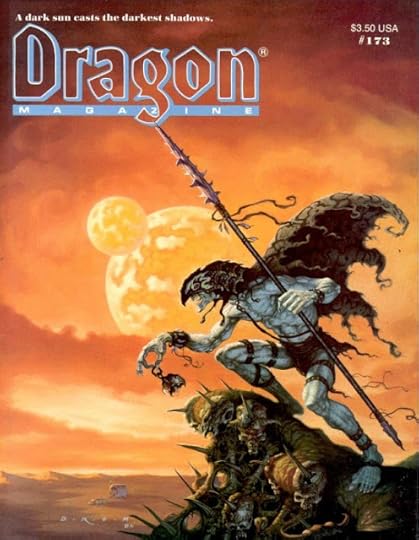
October 10, 2024
Character Trees
I hadn't intended to devote so many posts to Dark Sun, but they've proven quite popular and have generated a lot of discussion, so I thought I'd do a few more that I think have a wider relevance for fans of old school roleplaying games. In its advertising, TSR frequently described the world of Athas as AD&D's "toughest challenge ever." This train of thought can found throughout the boxed set's rulebook as well, such as this paragraph:
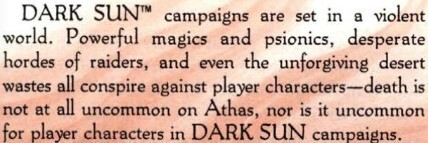 This paragraph appears under the section header "Character Trees," which continues:
This paragraph appears under the section header "Character Trees," which continues:
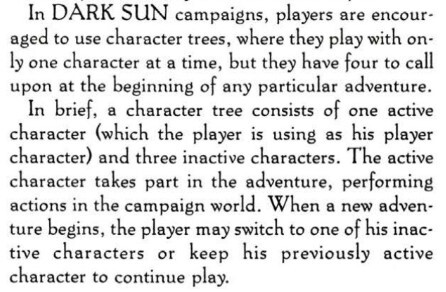 Since it's been so long since I last read Dark Sun, I'd completely forgotten about the existence of character trees. When I re-read this section, I immediately thought of Goodman Games's Dungeon Crawl Classics Role Playing Game and its "character funnel."
Since it's been so long since I last read Dark Sun, I'd completely forgotten about the existence of character trees. When I re-read this section, I immediately thought of Goodman Games's Dungeon Crawl Classics Role Playing Game and its "character funnel." For those of you unfamiliar with a character funnel, it's an adventure for DCC RPG in which each player generates four 0-level characters to throw at its dangers. At the conclusion of the adventure, the player chooses which of these four – assuming any survived – to elevate to level 1 and become his player character. DCC is dangerous, even for characters of levels 1 and above; it's especially dangerous for level 0 characters. Consequently, many of them die during the course of a funnel and it's not at all uncommon for a player to have to generate a second (or third ...) set of four characters to get through the funnel with one still alive at the end.
I've played through several funnels and they're a lot of fun. They're a great way to introduce new players to Dungeon Crawl Classics – not just its game mechanics but also its embracing of randomness as a gateway for unexpected fun. The other thing I really like about funnels is that I never know which of my four level 0 characters is going to be the one that makes it out alive. Often, it's the one I least expect, which I find delightful. Left to my own devices, I tend to fall into the same old ruts when it comes to generating a new character. Leaving the final decision to Fate breaks me free of that.
Now, Dark Sun's character tree concept is actually quite different from DCC's character funnel, but I nevertheless wondered if maybe there'd be some influence. The character tree is intended to provide players with a source of back-up characters whose levels are not too far below those of their current characters. This is a concern because the world of Athas is a dangerous one, player characters will die often. Since no one wants to replace a higher-level character with a 1st-level one, having three others as part of a tree is insurance against that.
A player in Dark Sun may only play one character in his tree at a time. The other three are inactive and may only be activated between adventures, upon the death of the current character, or – rarely – during an adventure. Only the current characters gains experience points. However, upon the current character's gaining a level, one of the other three characters in the tree also goes up a level as well. This happens every time any played character in the tree advances. Ideally, the player will be swapping between characters, thereby ensuring that most of them are within a level or two of each other. Even if he doesn't, at least one of them should be fairly close to the level of his current character, thereby obviating the need to generate a new level 1 character.
I think there's something to the idea of a character tree, though it's really only needed if the referee is a stickler about requiring that a new character enter the campaign at level 1 without exception. It's been my experience that most referees are fairly flexible about this, though strict, by-the-book AD&D, even in the 2e era, discourages this practice. I've generally been more inclined to let replacement characters begin at or close to the average level of the remaining ones, but maybe I'm too lenient. I'd be curious to hear others' opinions about this, especially if they're based on experience born of play in a campaign.
The Dawn of a New World
Here's another teaser advertisement for Dark Sun, from Dragon #172 (August 1991) – a month before the formal release of the game. What stands out to me about this ad is that it calls the setting AD&D's "toughest challenge ever" or some variation thereof. This makes me wonder more about the genesis of the setting within TSR and what segment of the game's audience the company was hoping to attract.
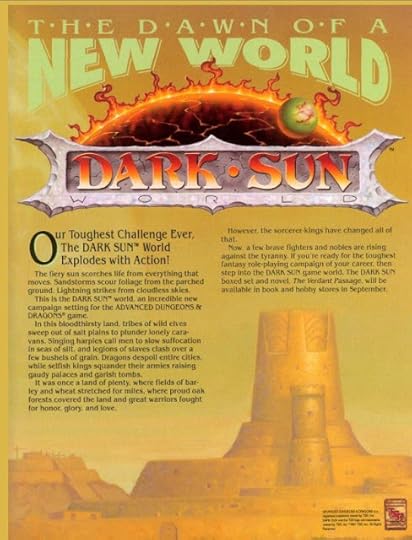
October 9, 2024
A Drama of Unparalleled Heroics Unfolds
The second teaser advertisement for Dark Sun, this one appearing in issue #171 of Dragon (July 1991).
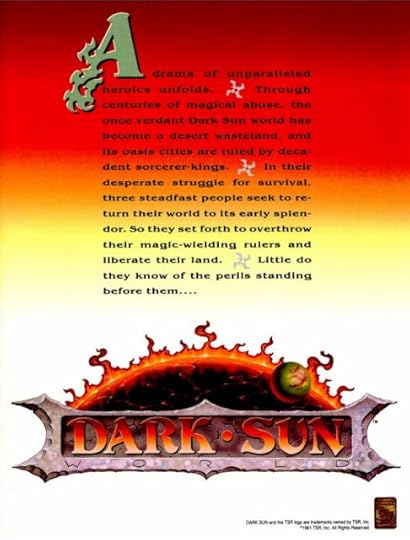
Coming This Fall ....
From issue #170 of Dragon (June 1991), the first of several teaser advertisements for the Dark Sun campaign setting.
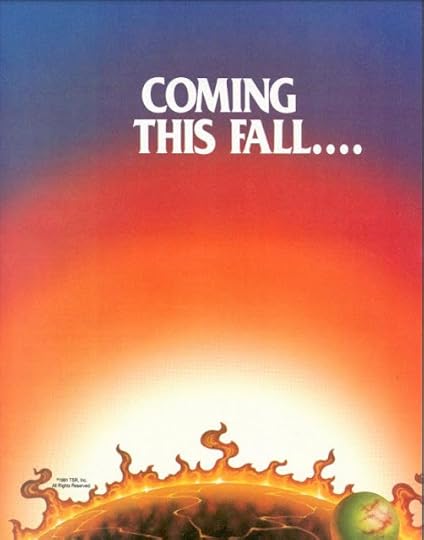
October 8, 2024
Retrospective: Dark Sun
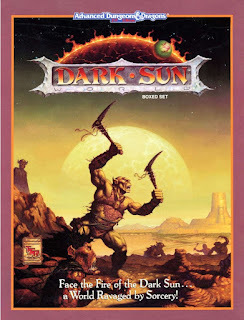 Having devoted last week's Retrospective post to
The Complete Psionics Handbook
, my thoughts inevitably turned to 1991's Dark Sun campaign setting – a setting specifically created to provide a place for Second Edition AD&D fans to make full use of the game's new psionics rules without having to worry about the potentially adverse effects these psychic powers might have on, say, the Forgotten Realms or the World of Greyhawk.
Having devoted last week's Retrospective post to
The Complete Psionics Handbook
, my thoughts inevitably turned to 1991's Dark Sun campaign setting – a setting specifically created to provide a place for Second Edition AD&D fans to make full use of the game's new psionics rules without having to worry about the potentially adverse effects these psychic powers might have on, say, the Forgotten Realms or the World of Greyhawk. Designed by Timothy B. Brown and Troy Denning, Dark Sun was presented as "a world ravaged by sorcery" and "the most challenging AD&D game world yet." This new setting took inspiration from both the post-apocalyptic and Dying Earth sub-genres, with a dash of Burroughsian sword-and-planet for good measure. Dark Sun was thus a significant departure from the vanilla fantasy of traditional D&D and AD&D. This departure wasn't just in terms of its content, but also its presentation, making ample use of the dark, edgy art of Gerald Brom and Thomas Baxa, two relative newcomers to TSR's stable of artists, who, together, created an esthetic for Dark Sun that clearly differentiated it from everything the company had previously done.
Like all of TSR's settings for Second Edition, Dark Sun was released in a large, boxed set, filled to the brim with gaming materials. The two main components of the set were 96-page softcover books. The first of these, entitled simply "Rules Booklet," presented new and altered AD&D rules for use with the setting. The second, "The Wanderer's Journal," was an in-character presentation of the "arid and bleak" world of Athas, which is "beset by political strife and monstrous abominations, where life is grim and short." Also included was a 16-page booklet, "A Little Knowledge," which consists mostly of a short story but also includes details of an adventure. The adventure proper is presented in two small 24-page, spiralbound flip books, one of which has illustrations to show players, like those in Tomb of Horrors or Expedition to the Barrier Peaks. Also included are poster maps of the city-state of Tyr and the region in which it's situated, known as the Tablelands.
Before getting on to the actual content of the boxed set, I'd like to say a little more about its presentation. Dark Sun is an impressive package. I remember when I got copy of it, being quite taken aback not only by how much was included in the set, but also by the unique format it took. This was particularly true in the case of the flipbooks, something I'd never seen previously in an AD&D product (or indeed any RPG product that I can recall). I suspect that they were intended as something of an experiment by TSR, one that carried over into most of the adventures subsequently published for the setting. I never really warmed to this format, which was in my experience quite unwieldy, which is one of the reasons I didn't buy any of those adventures. I'll get to the other reason shortly.
Athas itself is a very imaginative and engaging setting – sort of a cross between Barsoom and Zothique. As presented in "The Wanderer's Journal," the world's history is fragmentary at best. All that is certain is that present-day Athas is a shadow of its former self, its land ravaged by sorcery run amok and littered with the ruins of happier, more sophisticated times. Now, Athasian civilization is centered around scattered city-states, each ruled by an immortal sorcerer-king, who protects his subjects from the dangers of the wasteland in return for utter obedience. The sorcerer-kings also war amongst themselves, each attempting to expand his control of the Tablelands at the expense of his rivals, while various factions within and without attempt to take advantage of the situation.
Though intended for use with AD&D 2e, Dark Sun makes many changes to the standard rules and assumptions of the game. Though all of the usual AD&D races are available, many are changed significantly, like the halflings, who are wild, feral beings reputed to engage in cannibalism. Joining them are new races, like muls (half-human/half-dwarf hybrids bred for their hardiness), half-giants, and thri-kreen. Character classes are similarly affected, with all being changed (or outright disallowed, like the paladin) in some way. Wizards, for example, must decide whether to increase their power by employing defiling magic that destroys the environment – the reason Athas is now barren – while clerics serve not gods, which don't exist in this setting, but the elemental forces of nature.
Psionics also play a major role in Athas, with psionicists being common throughout the setting's population. Most intelligent beings – and many unintelligent ones, like monsters – are able to wield the powers of the mind. Psionics is, in many ways, more important in Dark Sun than is magic, though both have their place. In fact, magic and psionics can be employed together and it's explained that the sorcerer-kings owe their power and immortality to being able to wield both. "The Wanderer's Journal" suggests in various places that the relationship between magic and psionics played some sort of role in the ancient apocalypse that laid waste to Athas, thereby setting up a mystery that would be explored in later supplements and adventures.
This is where, in my opinion, Dark Sun faltered. The adventures produced for it all centered around major events within the setting, like the slave revolt that overthrows the sorcerer-king of Tyr and establishes it as a free city. Later adventures build upon these events, further changing and altering the setting as Big Things happen in accordance with a plan established by TSR. This isn't an inherently terrible way of developing a setting, though it's not my preference. However, what made it frustrating was that many of the setting's big events, like the aforementioned defeat of the sorcerer-king, are the result of actions by named NPCs, not the player characters. Furthermore, some of these events even happen in the pages of tie-in novels rather than adventures – a testament, I suppose, of just how popular and lucrative AD&D novels were in those days.
It's a pity, because Dark Sun is a genuinely imaginative and unique take on fantasy. Athas is a great setting, one with lots of possibilities for adventure, as well as a style and feel that differs from everything else that TSR was producing at the time. I was blown away by Dark Sun when I first bought it and really wanted to run a campaign with it. That never happened, for many reasons, but a big one was that I worried that TSR would, through its adventures or novels, derail whatever it was I had in mind with their event-driven releases. To be fair, the company did the same to the Forgotten Realms as well, but the Realms had the benefit of being standard fantasy and thus there was little need for any official guidance on how to use it. Athas, being new and different, would have benefited immensely from some better adventure material to aid referees looking to make use of the setting.
This is why Dark Sun will always be, for me, "the one that got away" – a fantasy setting that could have been fantastic and groundbreaking but instead never really achieved its full potential. A shame!
October 7, 2024
The Articles of Dragon: "Thieves' Cant: A Primer"
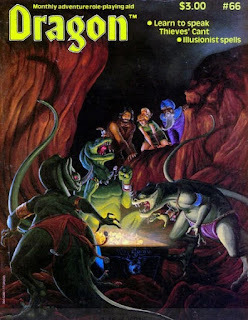 A great weakness of mine is constructed languages. While I can't say for certain – there's always the possibility that something else is to blame – I think it's quite likely that Appendices E and F of The Lord of the Rings planted the seeds of this lifelong fascination. I spent an inordinate amount of time reading those sections at the back of The Return of the King, especially the pages that displayed the Tengwar and the Angerthas. Likewise, when I got hold of The Silmarillion, I paid special attention to its appendix about Quenya and Sindarin names. Along with an old
Random House Dictionary of the English Language
, whose inside covers had diagrams of the evolution of Latin script, these books pretty much ensured I'd be a conlang nerd for the rest of my life.
A great weakness of mine is constructed languages. While I can't say for certain – there's always the possibility that something else is to blame – I think it's quite likely that Appendices E and F of The Lord of the Rings planted the seeds of this lifelong fascination. I spent an inordinate amount of time reading those sections at the back of The Return of the King, especially the pages that displayed the Tengwar and the Angerthas. Likewise, when I got hold of The Silmarillion, I paid special attention to its appendix about Quenya and Sindarin names. Along with an old
Random House Dictionary of the English Language
, whose inside covers had diagrams of the evolution of Latin script, these books pretty much ensured I'd be a conlang nerd for the rest of my life. Consequently, I always took great interest in language-related articles in Dragon or other RPG periodicals. Issue #65 (October 1982) featured several of these, all of which left a lasting impression on me. The first, which I'll discuss in this post, was ""Thieves' Cant: A primer for the language of larceny" by Aurelio Locsin. It's a fairly short article that is presented as a document from a fantasy setting detailing the grammar and vocabulary of Thieves' Cant, the secret language of thieves from Dungeons & Dragons.
Now, Thieves' Cant had, prior to this point, never, so far as I know, been described at any length in any D&D product. The AD&D Players Handbook merely calls it thieves' "own language" and says nothing more about it. I suspect it was on this basis that Locsin formed his ideas about how to approach creating a Thieves' Cant language for use with the game. He wanted to come up with something that had all the features of a "real" language – nouns, pronouns, modifiers, verbs and tenses, etc. – while still being simple enough that it didn't require a degree in linguistics to understand, let alone make use of it.
Of course, that's the crux of it: how were you supposed to use Thieves' Cant? What was its purpose? The article itself, as I said, is short and is presented in a detached, quasi-academic way, as if written by a scholar or linguist from within a fantasy setting, who's now sharing this secret language with the reader. There's, therefore, not even a sidebar or bit of boxed text hinting at how players or Dungeon Masters might make use of this constructed language in their adventures or campaigns. Instead, it's simply described, complete with a section in the center of the magazine that's supposed to be removed and then cut and folded to produce a 32-page two-way pocket dictionary of the language.
Another equally frustrating issue with the article is its very basis. Locsin's vision of Thieves' Cant is of an actual language, with its own distinct grammar and vocabulary, just as Elvish or Orcish would have their own distinct elements. This seems completely wrongheaded to me. Historically, thieves, criminals, and other outcasts have had their own unique ways of communicating with one another – you know, a cant or jargon that's known primarily by other members of group in question. There are innumerable examples of this in the real world and very few of them were created from the ground up by inventing a new grammar and vocabulary. It seems highly unlikely that Thieves' Cant would be an exception.
As I recall, the reaction to this article, both in the letters column of future issues and in later articles about languages in D&D, was not positive. I can't say that I disagree with those reactions. Re-reading the article in preparation for writing this post reminded me of just how weird and ultimately useless it is. I hate saying that, because it's clear Locsin put some effort into inventing the grammar and vocabulary, but I'm still left wondering why? What did he think would be done with the language? Heck, what did he do with the language in his own campaigns? Had he written about that, even a little, it might well have improved the article's utility. As it is, "Thieves' Cant: A primer for the language of larceny" is just an oddity and nothing more.
Fortunately, I have better things to say about this issue's other articles about language.
Brotherly Love Bulletin
From issue #66 of Dragon (October 1982) comes this full-page advertisement for Gangbusters. I haven't played the game in decades, but it was a favorite of mine for a couple of years after its original release back in 1982. Though I haven't (yet) done so, I occasionally get the hankering to pull it off the shelf and play it again. It's a fun little RPG with a lot to recommend it.
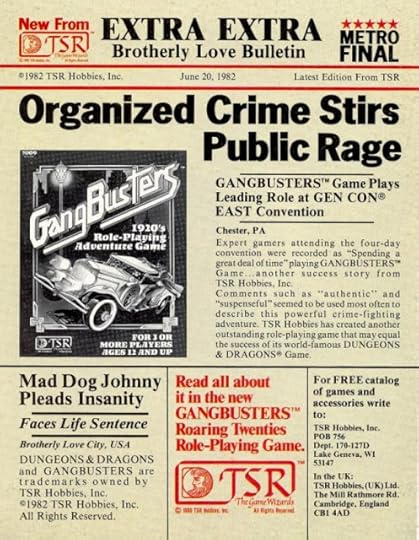
October 6, 2024
800-lb. Gorilla
 Last week's post, Pretenders to the Throne, was occasioned by my frustration about the fact that, in general, posts about Dungeons & Dragons tend to get more views and generate more comments than those about any other RPG. Now, on one level, that's just common sense. Not only is D&D the first and most well-known roleplaying game, but it's also been the most popular one for a half century now. No matter how many players of other games might despair of this fact, it's true. Dungeons & Dragons is and always has been the only roleplaying game whose name is recognizable outside our little hobby – or indeed inside some segments of it. In my experience, there are far more gamers who play only D&D than there are gamers who play a wide variety of them.
Last week's post, Pretenders to the Throne, was occasioned by my frustration about the fact that, in general, posts about Dungeons & Dragons tend to get more views and generate more comments than those about any other RPG. Now, on one level, that's just common sense. Not only is D&D the first and most well-known roleplaying game, but it's also been the most popular one for a half century now. No matter how many players of other games might despair of this fact, it's true. Dungeons & Dragons is and always has been the only roleplaying game whose name is recognizable outside our little hobby – or indeed inside some segments of it. In my experience, there are far more gamers who play only D&D than there are gamers who play a wide variety of them.As commenter Rick noted the other day, that's the power of branding. By getting to publication first and by having a title that's both evocative and easy to say, Dungeons & Dragons has a number of advantages that make it uniquely well placed to be the leader of the pack. I remember some years ago, back when Hasbro first bought Wizards of the Coast, reading an article in some business magazine that the name Dungeons & Dragons was one of best known in the world, alongside things like Coca-Cola and Kleenex. While most people had no real sense of what D&D actually was – most, I think, believed it to be some kind of video game – they nevertheless had at least heard of D&D, something that could not be said about any other RPG, no matter how successful or celebrated it was within the hobby.
Being the most well-known is not, of course, an indication of quality, a point frequently made by partisans of different, less-known brands, both within and without our hobby. Anyone who prefers Pepsi to Coke or Burger King to McDonald's, to cite just two rather prosaic examples, probably feels this way. Believe me, I'm sympathetic to this point of view. As a fan of Traveller, for example, I wish the game were better known, appreciated, and played than it is at present, but, as the old saying goes, if wishes were credits, beggars wouldn't need to travel by low passage. I make this joke to illustrate my point about just how obscure RPGs other than D&D are, even within the hobby. How many of you reading this post knew what I was talking about? (There's no need to answer that.)
I love lots of roleplaying games. Last year, I did a two-part post about my ten favorites – and I have many more besides. But I know only too well that, if I were to write lots of posts to discussing, say, Pendragon or Gamma World, they'd be among my least read posts and certainly the least commented upon. As you all know, I've been refereeing an Empire of the Petal Throne campaign for the last nine and a half years and, despite that, my posts about that campaign and its setting of Tékumel don't receive a lot of attention or comment. Don't misunderstand me: I completely understand why that is the case. Neither Empire of the Petal Throne nor Tékumel are widely known even within the hobby, so why would I expect posts about them to generate much attention?
And that's really my point. I write so much about Dungeons & Dragons and its history here, because D&D is the single most widely known and played roleplaying game, even in 2024. Those of us who enjoy more than just D&D are very apt to claim that we're presently living in a Golden Age of Roleplaying, with more games and more variety of games than ever before. That might well be true by some metrics, but, on one significant metric – popularity – nothing much has changed. Dungeons & Dragons remains the game most people are playing and that most people, even those of you reading this blog, are interested in reading about. It's not for nothing that I use a version of Trampier's iconic demon idol in my masthead.
What does this all mean? Honestly, I'm not sure. Though it's not my favorite RPG, I still very much like D&D, so I don't think there's any chance I'll stop writing posts about the game and its history. However, my frustration with the fact that it's those posts, with a few exceptions, that tend to generate the most interest is very real. I don't like writing stuff that garners little or no interest. Who, after all, likes to feel as if he's shouting into the void? At the same time, I cannot expect most readers are going to be familiar with all the same obscure things that I am or that they'll share my interest in the same. To some extent, if one is going to write for public consumption, one must write what will attract the most readers and, in my case, that means posts about Dungeons & Dragons.
C'est la vie.
October 4, 2024
What's a Campaign? (Part II)
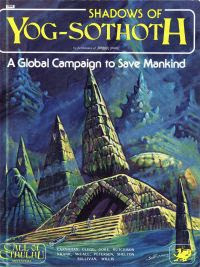 Yesterday, I pointed out a section in The Traveller Adventure that describes it as a campaign and then defines a campaign as "a complete set of adventures which provides a slowly unfolding drama to explore, investigate, and conquer." As I reflected on this, I was reminded that the subtitle for
Shadows of Yog-Sothoth
, the first stand-alone adventure for Chaosium's Call of Cthulhu, is "A Global Campaign to Save Mankind." So, what exactly is a campaign, at least in the view of Chaosium, circa 1982 (a year before the publication of The Traveller Adventure)?
Yesterday, I pointed out a section in The Traveller Adventure that describes it as a campaign and then defines a campaign as "a complete set of adventures which provides a slowly unfolding drama to explore, investigate, and conquer." As I reflected on this, I was reminded that the subtitle for
Shadows of Yog-Sothoth
, the first stand-alone adventure for Chaosium's Call of Cthulhu, is "A Global Campaign to Save Mankind." So, what exactly is a campaign, at least in the view of Chaosium, circa 1982 (a year before the publication of The Traveller Adventure)?The introduction to Shadows of Yog-Sothoth includes a "How to Use This Book" section that provides some insight into this matter, though, as we'll see, there are still complexities to be explored.
Shadows of Yog-Sothoth is divided into two main sections. The first part is a lengthy campaign of seven scenarios, from which the entire book takes its name. The second part is much shorter, and is a pair of bonus scenarios; unrelated to the first part, or to each other.
The first part of the book is meant to be played as a fully campaign, and those scenarios should be followed in the order that they are laid out in this book ...
As with The Traveller Adventure, we say a campaign as being defined as a collection of linked scenarios built around a common focus, in this case defeating the plans of "a sinister occult organization, led by the evil Lords of the Silver Twilight," as the introduction goes on to explain.
Speaking of the introduction, a later paragraph sheds some further light on the meaning of a campaign. After discussing how the campaign is structured – seven scenarios, each of which leads into the next one – it goes on to say:
If your particular mode of play is not suited to a series of linked adventures, such as this book consists of, the individual scenarios may certainly be played by themselves.
This sentence suggests that Call of Cthulhu has two "modes" of play: one based around individual scenarios and one based around "a series of linked adventures," which is to say, a campaign. Interestingly, the back cover of Shadows of Yog-Sothoth describes itself as a "scenario book for the CALL OF CTHULHU role-playing game. SHADOWS OF YOG-SOTHOTH is a seven-chapter tale of horror and suspense." Here, each integral scenario of the campaign is likened to a chapter, the whole – the campaign itself – being called a "tale of horror and suspense."
Chapter VII of the second edition of Call of Cthulhu bears the title "How to Play the Game." Here, we once again see that a "campaign" is defined as being made of several scenarios that
ought to be arranged like the branches of a tree. The players start out fooling around with the very tips and edges of the mythos, where there are dozens of myths, legends, clues, and adventures. As they gain knowledge and experience, the investigators will work their way inwards, where there are fewer happenings, of greater importance. At the center of the mythos reside the hideous Elder Gods in all their reality. The final goal of play may well be to save this planet and force the retreat of Cthulhu and other space beings. Becoming powerful to do that may take years.
Words like "scenarios," "adventures" and even "play" are used without precision. Are they all the same thing or are there fine distinctions between them? Where does a campaign fit into all this? That's why I find myself wondering whether anyone at Chaosium at the time had a clear sense of it themselves or whether we, in the present, are expecting a degree of clarity that no one at the time needed, let alone expected. Still, it's yet more grist for the mill as I delve more deeply into campaigns, their meaning, and how they were run during the first decade of the hobby.
James Maliszewski's Blog
- James Maliszewski's profile
- 3 followers



